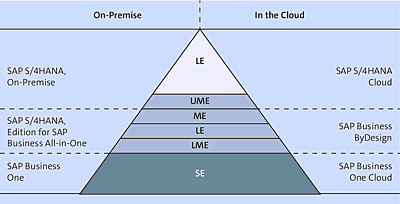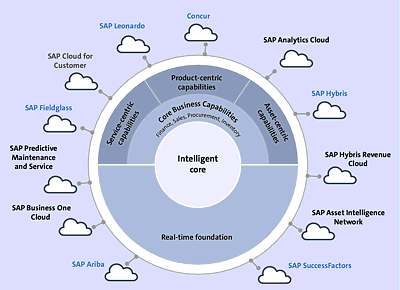1 The Basics: What Is SAP S/4HANA Cloud?
With the SAP S/4HANA, cloud edition, we are delivering on our promise to give complete choice to customers for adopting the next-generation business suite.
—Bernd Leukert, member of the Executive Board, Products & Innovation, SAP SE
In this chapter, we’ll provide a high-level overview of some of the basics of SAP S/4HANA Cloud from a prospective buyer’s perspective. The goal of this chapter is to summarize the salient components of SAP S/4HANA Cloud in terms of functionality, platform, infrastructure, and postproduction support at a thousand-foot level. Knowing the basics behind SAP S/4HANA Cloud helps organizations understand how the product fits a customer’s specific ERP needs and whether additional exploration is necessary.
Before we begin, we’ll highlight the importance of speaking the challenging language known as SAPanese in the following box.
The Ancient Language of SAPanese
For those new to the world of SAP, SAPanese (i.e., the global language of SAP-speak) can be foreign and intimidating, without question. With terms, versions, modules, products, and acronyms rolling off the tongue effortlessly from seasoned SAP professionals, following conversations—especially those technical in nature—can become difficult quickly without a solid foundation. Thus, we’ve done our best throughout this book to translate all SAPanese by spelling out and explaining terms that might not be self-evident. With a bit of practice, you too can speak SAPanese fluently.
1.1 Overview
SAP S/4HANA Cloud is SAP’s newest and most innovative software as a service (SaaS) ERP product. Although SAP has built and invested in previous small to midsize business ERP products (such as SAP Business One and SAP Business ByDesign), none of the earlier offerings have had as much investment, energy, or SAP executive sponsorship as SAP S/4HANA Cloud.
Why is SAP investing in cloud ERP? It’s not change for the sake of change. Instead, cloud provides the perfect platform to drive speed and deliver results. Businesses are going to realize it’s not a matter of if, but how they start with cloud ERP.
New digital technologies and capabilities are disrupting business models across entire sectors. SAP has identified a need for cloud ERP that’s easy to use, packed with latest technologies, such as SAP CoPilot and machine learning, comes with a UI tailored to every person in an organization, and underpinned by powerful business capabilities. The idea is to combine SAP’s end-to-end processes with the speed of cloud delivery to power digital transformation and agility. This approach to intelligent cloud ERP provides users with software that is easy to use and provides contextual experiences and interactions to help users be more efficient—freeing up resources for innovation—while at the same time helping them make better strategic decisions.
Figure 1.1 shows how SAP distinguishes internally among SAP products targeting the small to midsize market based on user count.
Figure 1.1 ERP Product Portfolio Breakdown
Built on the same code base as SAP’s flagship enterprise-level business software (on-premise SAP S/4HANA), SAP S/4HANA Cloud provides functionality very like its sibling’s. However, the there are some very important differences between the two products. In turn, who should implement which product (as discussed in Chapter 2) is likewise quite different.
Before we dig much deeper into what exactly SAP S/4HANA Cloud is, a cheat sheet of key facts about the software will provide a good starting point (see the following box).
SAP S/4HANA Cloud Fact Sheet
Note the following ten key facts about SAP S/4HANA Cloud:
-
Software subscription pricing is per user, per month.
SAP S/4HANA Cloud’s software pricing structure mirrors the standard cloud pricing construct of a monthly cost per user. The on-premise pricing construct of and initial upfront cost per user along with annual maintenance fees is no longer applicable to this cloud product. The barrier for entry (i.e., the cost of the software) is much lower than for on-premise ERP from SAP. This new enterprise-level ERP pricing structure enables mid-sized businesses with $20 million in annual revenue or more as well as smaller, but fast-growing business to implement SAP S/4HANA Cloud as their business software backbone. -
Implementing is measured in weeks, not years.
As a generalization, the implementation time to deploy SAP S/4HANA Cloud is measured in weeks, as opposed to the months (or even years) needed to implement other ERP products from SAP on-premise. Because of the intuitive and contextualized browser-based UI, users can also start with far less training. This rapid implementation schedule is no coincidence; SAP has adopted the greater cloud software model of accelerated plug-and-play deployment. The hurdle of expensive implementation timelines and costs is no longer applicable here. Again, this rapid ERP SaaS deployment schedule from SAP now provides options previously unavailable for companies with less than $250 million in annual revenue (a loose benchmark metric used within the SAP world). -
SAP Best Practice configuration is ready out of the box.
One of the value propositions of SAP S/4HANA Cloud is that configuration options are more limited on purpose. Based on designing the product via SAP Best Practices, SAP S/4HANA Cloud’s tight control over configuration options deliberately drives customers towards standard deployment. Wizard-based configuration based on SAP Best Practices greatly accelerates SAP S/4HANA Cloud’s initial set-up timelines and ongoing postproduction support needs. By using their decades of experience with industries and steering customers toward the most efficient processes for standard functions, SAP is helping customers focus their energy instead on growing capabilities that differentiate them in the market. -
Postproduction can be self-supported.
Speaking of standard deployment, and because of the out-of-the-box implementation model, postproduction support requirements are nominal if not nonexistent. No longer are organizations required to either build robust SAP support teams or engage vendors to keep their SAP systems running effectively and current. In turn, SAP S/4HANA Cloud provides low total cost of ownership (TCO). SAP S/4HANA Cloud’s postproduction support essentially becomes a business-driven business-analyst model in which superusers are empowered to support the system from a business functional perspective instead of the traditional SAP technical upkeep driven by configuration and development requirements. Large SAP support staffs are no longer required! (There is one exception related to extensibility, which is discussed in Chapter 9.) -
Innovation is fast and quarterly.
SAP S/4HANA Cloud’s innovation strategy is vastly different than that for SAP’s on-premise ERP model. Again, this is intentional and meant to drive more customers towards cloud. SAP S/4HANA Cloud innovation cycles are quarterly (i.e., SAP pushes out new functionality to its clients every 90 days), whereas SAP’s ERP on-premise functionality enhancements are delivered on a yearly schedule. One of the advantages of this innovation model/schedule is that new SAP S/4HANA Cloud functionality is automatically delivered. This means customers get access to the latest technologies, such as machine learning capabilities, with every regular update cycle. One of the potential disadvantages of this model is that new functionality deployment is no longer optional but mandatory. -
SAP S/4HANA Cloud isn’t the right fit for everyone.
One of the advantages of SAP S/4HANA Cloud is the simplicity of its implementation, based on its SAP Best Practices–driven functionality. For organizations that can leverage standard business processes (which includes most organizations), SAP S/4HANA Cloud can be a great fit; however, for businesses requiring industry-specific functionality, it might not be. At the time of writing, SAP S/4HANA Cloud supports industry-specific functionality for professional services and component manufacturing. Support for several industries such as oil & gas, chemicals specialty, public sector, telco, banking, and consumer products is on its way, with more industries will following in 2018. -
SAP S/4HANA isn’t just for smaller companies.
One of the biggest growing SAP S/4HANA Cloud use cases is (drum roll, please) for large enterprise organizations. Although SaaS utilization in general is wide and ubiquitous within the start-up and midmarket sectors—therefore providing a great use case for SAP S/4HANA Cloud—large enterprise companies (businesses loosely defined as having annual revenues/turnover exceeding $1 billion) also are embracing SAP S/4HANA Cloud within a two-tier ERP architecture. Attracted by the cost, speed, and necessary functionality for smaller divisions, large enterprises are deploying SAP S/4HANA Cloud for subsidiaries, smaller divisions, satellite offices, and the like and then integrating SAP S/4HANA Cloud with their primary SAP ERP installations (SAP ERP or SAP S/4HANA). This model is a two-tier federated strategy. It gives the smaller division/entity more agility and speed while maintaining total integration with the systems of record in the rest of the organization. More information about this hybrid ERP approach will be discussed later in this chapter. -
SAP’s investment in SAP S/4HANA is mind-blowing.
In more than 22 years, we’ve never before seen this much investment of resources, executive leadership, marketing, salesforce, and development into a single product. The effort, energy, investment in resources, etc. alone being displayed by SAP as an organization proves SAP S/4HANA Cloud’s significance as a flagship product. Clearly, SAP sees intelligent cloud ERP as the future of ERP for digital business because of the way it combines speed and results—speed in deployment and user adoption, results in faster time-to-value and continuously expanding capabilities with new releases. -
SAP S/4HANA Cloud is from the same code line as on-premise SAP S/4HANA.
SAP S/4HANA Cloud’s code base foundation is the same as that of the on-premise version. Why does this matter? It means that SAP S/4HANA Cloud possesses much of the same functionality as SAP’s flagship on-premise version. Unlike previous (and current) SAP midmarket ERP solutions, such as SAP Business All-in-One, SAP Business One, and SAP Business ByDesign, SAP S/4HANA Cloud is in sync with the enterprise version. -
SAP S/4HANA Cloud is extensible.
For some customers, SAP S/4HANA Cloud might not be sufficient to cover all needed business functions. SAP understands this, and so SAP S/4HANA Cloud has been designed as a digital core, enabling additional desired functionality to be added through extensibility via SAP Cloud Platform. Extensibility includes native integration with other SAP products such as SAP SuccessFactors for human resources, integration with third-party applications, or customer-specific functionality created via SAP Cloud Platform, the system integration is there to extend core SAP S/4HANA Cloud’s business functionality. SAP is also rolling out a new model of customer collaboration: the SAP S/4HANA Cloud software development kit (SDK). The SDK will enable customers to build out new industry-specific capabilities and use the SAP App Center as a go-to-market platform.
These ten key facts about SAP S/4HANA Cloud make a compelling case for organizations both familiar with and foreign to SAP ERP to look at this solution for running their business.
SAP is strategically positioning SAP S/4HANA Cloud as the nexus of SAP’s digital cloud core. Wall Street values cloud revenue at higher multiples than traditional, on-premise-driven revenue, and SAP is following suit by moving more and more functionality to the cloud. Large acquisitions over the last decade, including SAP Hybris, SAP Fieldglass, SAP Ariba, Concur, and SAP SuccessFactors, have clearly sent messages to the market that SAP is invested and will grow investment in the cloud.
Figure 1.2 S/4HANA Cloud as the SAP Cloud Digital Core
As shown in Figure 1.2, SAP S/4HANA Cloud sits in the middle, the nexus for all SAP Cloud Platform products, which are specialized for distinct business process domains. This modular plug-and-play approach from SAP presents the consumer with an understanding that various business processes can be tackled by connecting and integrating multiple SAP products and non-SAP applications (including custom apps).

